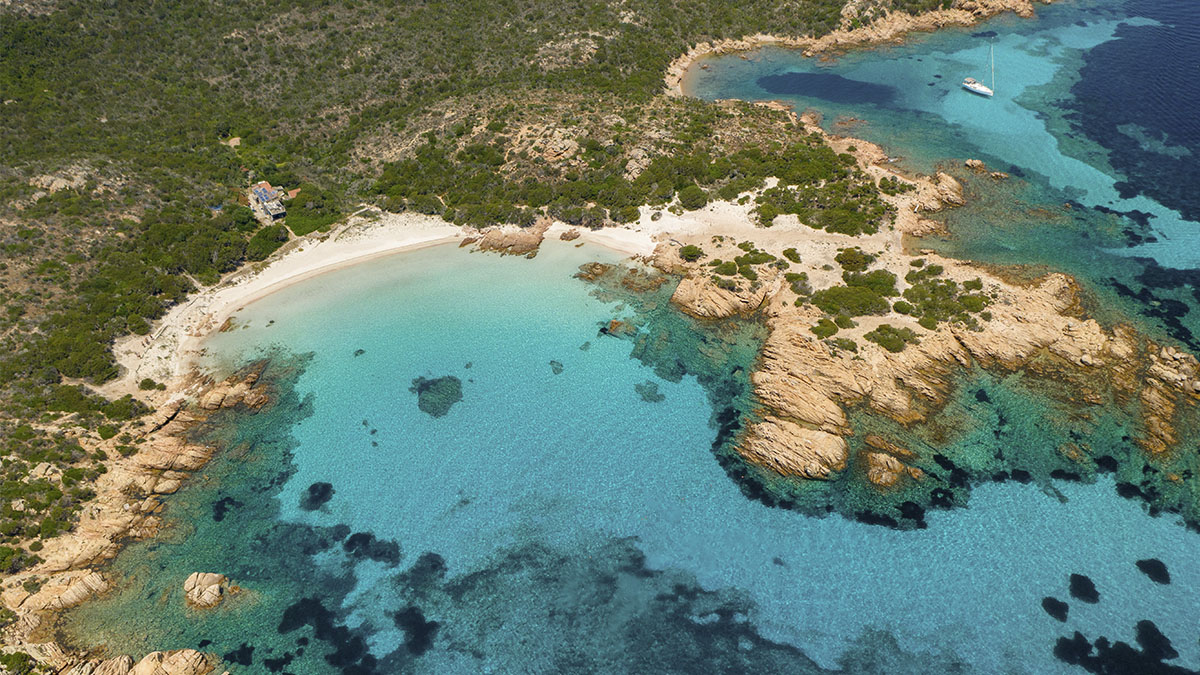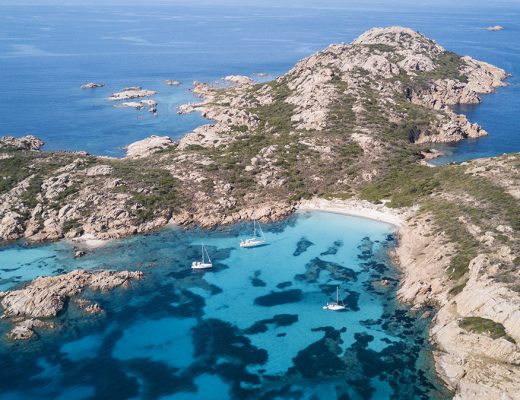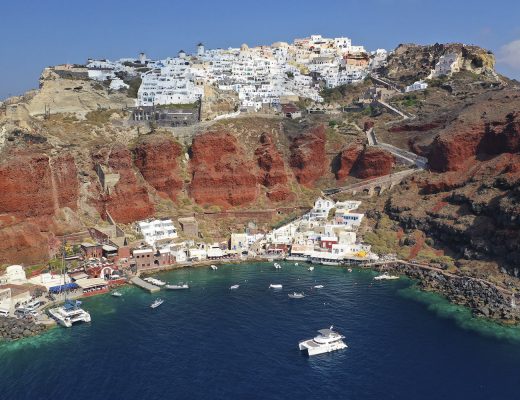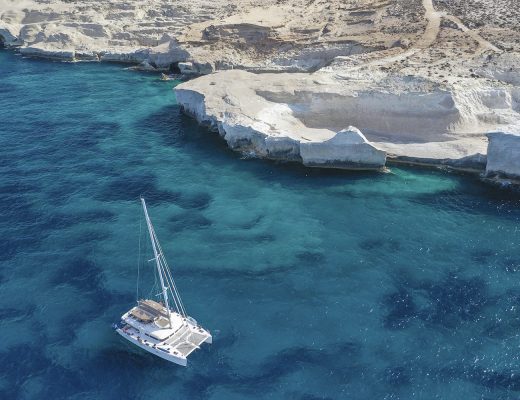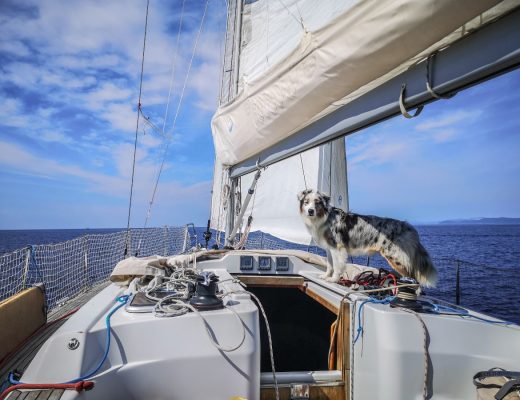In general, the best sailing grounds offer plenty of landing spots, mooring places and safe anchorages. These areas will also have spectacular natural scenery and picturesque human settlements such as fishing villages and harbours.
Its largely jagged coastline and its wealth of history, architecture and gourmet food make Italy a true paradise for nautical tourism. It also boasts a vast number of UNESCO World Heritage sites – more than any other nation in the world.
Italy’s main islands, archipelagos and coastal areas are rich in natural bays and inlets, sheltered from the wind, alongside well-equipped harbours and marinas where you can berth if the weather conditions aren’t suitable for sailing. These are ideal places for winding down on shore, perhaps enjoying a hike in the countryside, a visit to a museum or archaeological site. Alternatively, you can browse around boutiques, sample some local cuisine or enjoy an ‘aperitivo’ at a bar.
Plus, there are never too many nautical miles between one gorgeous spot and the next! The result is a holiday that’s packed full of excitement and new things to discover daily. It will leave you with an unforgettable set of experiences.
In short, Italy has everything it takes to be an ideal cruising ground. In this article, we want to give you some tips on the most beautiful islands and coastlines to explore on a yacht cruise. So take your pick, and happy sailing!
- Liguria: a poetic seascape and charming colourful villages
- Tuscan archipelago: a sailor’s paradise with nature, history and culture
- North Sardinia: “Caribbean” beaches and glamour
- South Sardinia: remote bays, watchtowers and turquoise waters
- Pontine Islands: the rainbow-coloured archipelago
- Neapolitan Islands and the Amalfi Coast: where myth meets nature
- The seven sisters of the sea: the Aeolian islands
- Aegadian Archipelago: fishing tradition and an endless summer
- Tremiti Islands and Gargano: immaculate beaches, rocky coves, caves and an open-air museum
- Salento: Lecce’s Baroque architecture, beaches to rival the Maldives, olive groves and castles in the Heel of Italy
- Northern Adriatic: from the magic of Venice to the unspoilt Croatian coast
Liguria: a poetic seascape and charming colourful villages
Its east coast, the Riviera di Levante, offers natural and marine landscapes that are the envy of the world.
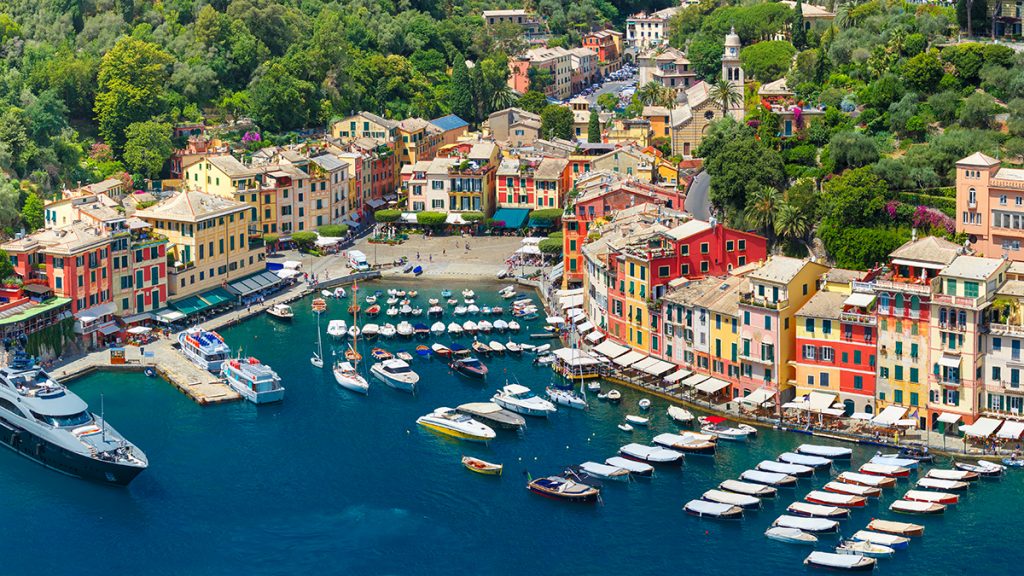
Setting off from the Bay of Poets, the deep gulf at La Spezia, set between two headlands, we discover romantic Portovenere and, beneath the castle, Byron’s cave with its sheer white cliff. Then we come to the Cinque Terre (on the UNESCO World Heritage list since 1997). Straight out of a fairytale, this string of colourful fishing villages (with houses painted red, yellow, pink, green, blue) stands perched high above the rocky coastline. Over the centuries the local people have built terraced vineyards and olive groves, and carved out hillside paths with a sheer drop to the sea – it’s a hiker’s dream come true!
As we gradually sail westwards, a veritable “film set” unfurls before our eyes, evocative of ancient seafaring traditions and modern vacationing alike, particularly the jet set’s most beloved spots. One such resort is Portofino, loved by Guy de Maupassant, Guglielmo Marconi, Arnoldo Mondadori and Walt Disney, not to mention hordes of screen idols, popstars, athletes and politicians, past and present. This elegant village is proud of its solid maritime tradition. It stands upon a picturesque half-moon bay within the Regional Natural Park and Marine Reserve of Portofino.
Then there’s Camogli, which gazes out onto the Golfo Paradiso, or ‘Bay of Paradise’, a name that speaks for itself. One good reason to take the tender and step ashore is to get a closer look at the town’s striking buildings painted in sunny colours, with their trompe l’oeil decorations of pedestals, cornices and closed shutters. The other, excellent reason is to sample the town’s famous ‘focaccia camoglina‘, in various flavours – with cheese, onion, or olives and oregano. A taste of this local delicacy is the perfect way to end your cruise.
Colourful, magical, elegant. Liguria is a must-see.
Look at our fleet of yachts and catamarans and set sail!
Discover the boat rentals available in Liguria
Tuscan Archipelago: a sailor’s paradise with nature, history and culture
As she rose out of the Tyrrhenian sea to reach her beloved Eros, Aphrodite lost the pearl necklace that Paris had given her. According to the myth, the goddess’s pearls floated on the surface and turned into the islands in the Tuscan Archipelago.
The islands of Elba, Giglio, Capraia, Montecristo, Pianosa, Giannutri and Gorgona (all protected within the Tuscan Archipelago National Park) are surrounded by ‘satellites’ of sea stacks and islets.
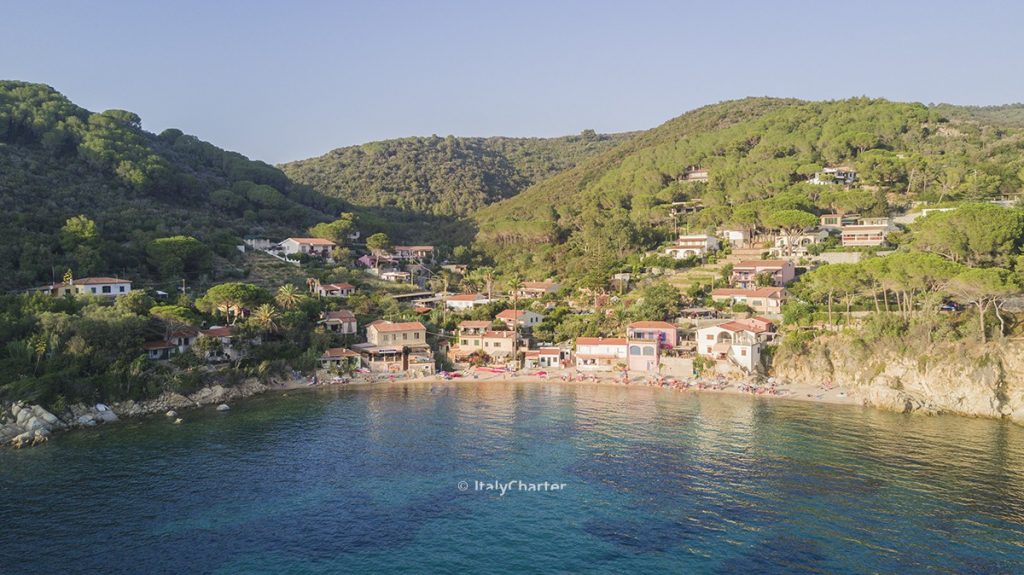
The largest is Elba, a lush island in the shape of a fish that seems to be heading for Corsica. A sailing holiday is the ultimate way to discover this gem. With its 150 km of jagged coastline, it is an endlessly fascinating cruising ground, even if you decide to spend one or two weeks touring its crystal-clear waters.
It is large enough to offer plenty of variety, and a wide range of natural, historic and architectural beauty spots. At the same time, it’s small enough to sail around in just a few days, with safe havens in case of winds from any direction.
In Tuscany you can admire beaches of every type and colour (white pebbles, or sandy beaches in shades of white, gold, grey, black or red), such as Sansone, Procchio, Fetovaia, Marina di Campo and Sant’Andrea. Then there are inlets, bays and little harbours to safely moor overnight, or natural pools for crowd-free swimming. Once on dry land, you can choose from around twenty towns and picturesque villages (by the sea or in the hills) to visit, such as Portoferraio, Marciana Marina, Marina di Campo, Porto Azzurro, Capoliveri and Rio nell’Elba.
This multi-faceted island has been blessed by nature, and was made famous by various historical figures including the Etruscans, the Medici dynasty, and Napoleon, to name a few.
Elba is a good base for setting off towards three of the other ‘pearls’ in the archipelago.
Heading north, we come to the volcanic island of Capraia, a small yet bewitching island covered in heather and myrtle. From Cala Mortola on the north-east side to Cala Rossa in the south, its coastline reveals a series of bays that are ideal for snorkelling and scuba-diving.
In the southern part of the archipelago, Giglio welcomes seafarers with its colourful houses clustered around the harbour, alongside fish restaurants, cafés and bars and its most scenic bays: Cala Cannelle and Cala Caldane.
Meanwhile, Giannutri is a small island with steep, rocky cliffs, dotted with caves. It doesn’t have many anchorages so we recommend visiting only when the weather conditions are good. But when the wind does make it possible to drop anchor at Cala Spalmatoio, a large, crescent-shaped bay on the southeastern side, it’s time to don some hiking boots and set off for an interesting guided excursion to the Roman villa, dating from the 2nd century AD. It’s a truly unmissable experience.
Do you yearn to discover the beauty of Tuscany?
On ItalyCharter you’ll find the best boats and itineraries.
See our Tuscany charter catalogue.
North Sardinia: Caribbean-style beaches and glamour
Nature – and the human hand – have crafted some spectacular special effects, right here in Sardinia.
Pink or pearly-white granite sculpted by the wind, glassy water where yachts seem to float upon a liquid sky, icing-sugar beaches, the night-life of Porto Cervo and Porto Rotondo, dream villas, the scented Mediterranean scrub… then there’s the galaxy of islands in the Maddalena Archipelago and the Strait of Bonifacio where the winds rule supreme.
Your constant companion will be the Mistral wind, which cools the island and dries out the air in summer; it will fill your sails and allow you to glide swiftly over the waves. When you need a break from the wind, there are plenty of bays sheltered by natural barriers (dunes, hills or pine forests) and inlets.

Setting sail for the Costa Smeralda from the main bases on the coast – Olbia or Portisco – you cruise northwards, passing rocky headlands, deep coves and beaches to rival the Caribbean. After Porto Rotondo – Sardinia’s second ‘VIP capital’ – you’ll encounter the famous bays of Cala di Volpe, Capriccioli, Romazzino, Pevero.
Landing in Porto Cervo one is immediately, pleasantly plunged into the international jet set’s summer playground. The luxury superyachts moored there speak for themselves.
The coastal area is packed with stunning spots. They include Poltu Quatu and the exquisite village of Liscia di Vacca, Porto Pollo and the beaches at Liscia Ruia, Razza di Giunco and the beach and the mouth of the River Liscia: in spring, the sand dunes burst into bloom with pink clouds of sea thrift.
In Palau you can admire the ‘Tomb of the Giants‘ archaeological site and the Roccia dell’Orso (‘Bear Rock’), a granite hill moulded by the wind and rain. In olden times, sailors used it as a natural reference point.
With its sixty-two islands and islets (including La Maddalena, Caprera, Santo Stefano, Budelli, Spargi), the Maddalena Archipelago is a must-see for sailors, offering plenty of fun along its 180 km of coasts, and a choice of three hundred beaches bathed by emerald-green water.
From here, you can head to the north-west and face the challenge of the Strait of Bonifacio. The Strait separates Sardinia from Corsica and must always be approached with respect, as it is scattered with rocks and crossed by strong currents. Your ‘reward’ will be the splendid Lavezzi islands: a scenic array of wind-hewn rocks rising from the turquoise sea, which is teeming with fish, starfish and sea urchins – a snorkeller’s paradise.
And the gleaming white cliffs on the Strait of Bonifacio are a sight to behold, with pastel-coloured houses clinging above the precipice.
Thinking of untamed, glamorous Sardinia for your next holiday?
Choose the right yacht or catamaran and prepare to set sail.
Browse our catalogue of boat charters in Sardinia
South Sardinia: remote bays, watchtowers and turquoise waters
Southern Sardinia will charm sailors, with its calm, unspoilt coasts, fragrant with juniper, mastic, myrtle, broom and olive trees. The rugged granite rocks in the north give way to a softer, verdant coastline dotted with watchtowers.
Whereas the Costa Smeralda is known for its jet-set glamour, here in the south the greatest luxury is silence – even at the height of the summer season. Golden sands are lapped by water in a palette from deep blue to turquoise. It’s not uncommon to come across placid cows foraging for grass on the edges of deserted beaches.

The ideal route for a sailing holiday would be along the coast from Carloforte to Cagliari – it’s easy to cover on a week-long charter. The Mistral is the wind that blows most frequently here, buffing the coast and pushing the waves, but the area is also exposed to the Libeccio (southwesterly) and Sirocco (southeasterly) winds.
The southern coast can be divided in two. The first section includes the Sulcis Islands: San Pietro and Sant’ Antioco (to the southwest of Sardinia), then from Porto Scudo as far as Porto Teulada. The second section is in the far south. It includes the mainly sandy stretch of coast from Capo Malfatano to Cagliari.
San Pietro has dizzyingly high, craggy cliffs (a nesting place for peregrine falcons, Corsican seagulls and the rare Eleonora’s falcon). The rough cliff face plunges into the crystal-clear sea, which is fantastic for diving, snorkelling and fishing. The island is fringed with enchanting bays, with fragrant rosemary, strawberry trees, dwarf palms and Aleppo pines.
The island is jam-packed with beautiful places to see and experience. From romantic Cala Vinagra (a pebble beach with emerald-green water) to the Le Colonne sea stacks; from colourful Carloforte, with its Ligurian cultural influences, to the seventeenth-century Tonnara (tuna processing plant) at La Punta.
Another snorkeller’s paradise with crystal water is Sant’Antioco, which is connected to Sardinia by a narrow causeway and a bridge. Cruising southwards we come to Porto Pino, with its pink sand and windswept dunes; and Cala Zafferano, a crescent of dazzling white shingle and shell fragments, with shallow water that reflects every nuance of the sky above. Meanwhile, Porto Scudo and Porto Teulada are remarkable for their imposing cliffs.
Continuing towards the southernmost part of the route, we encounter the rocky headland of Capo Malfatano, overlooked by a Spanish tower. The cape was chosen as a safe port by the Phoenicians, back in the 6th century BC. Immediately beyond it you can catch a glimpse of the ‘Caribbean’ beach of Tuerreda, a picture-perfect bay.
An exciting place to drop anchor is the bay of Chia, which is famous for its pink flamingo lagoon, amongst other things. The Mistral blows regularly here making it a mecca for surfers, who show off their spectacular acrobatics on the waves. In ancient times Chia was the site of first a Phoenician village, and later a Roman settlement called Bithia. The tower was built by the Spanish in the 17th century to keep lookout for corsairs. Beyond it is a strip of white sand, dotted with small inlets bordered by thick scrub and surrounded by jade-green water.
This is a good place to disembark and explore on dry land, including the archaeological site of Nora. This was Sardinia’s first Phoenician city (8th c. BC) and was a trading hub and a port that had an enviable position on the isthmus of Cape Pula, from where ships could sail no matter what the wind conditions.
Lastly, the harbour at Cagliari, the regional capital of Sardinia and a major hub for Mediterranean cruise ships.
This colourful, multi-ethnic city has a buzzing Mediterranean vibe. It overlooks the Golfo degli Angeli, or Bay of Angels, and is built on seven hills, just like Rome or Lisbon. It, too, was founded upon an ancient Phoenician settlement. Its four old quarters witnessed a chequered history of events, from pre-historic times to the period under Savoy rule.
Sights to see within the mighty city walls include medieval towers, baroque churches, noble mansions (such as Palazzo Regio and Palazzo di Città), the Roman amphitheatre, and the botanical gardens. When evening falls, head for the bars in the Castello quarter to finally let loose for some nightlife in the warm sea breeze.
A sailing holiday in heaven on earth?
That’s what you can expect if you choose southern Sardinia.
Rent a boat in Sardinia through ItalyCharter
Pontine Islands: the archipelago of magical colours
The Pontine Archipelago consists of six islands (Ponza, Palmarola, Zannone, Gavi, Ventotene, Santo Stefano). They were formed when colossal underwater eruptions created vast rocky masses, on which the detritus thrown up by the eruptions then settled. Once the volcanic activity had stopped, the wind and water acted as sculptors, chiselling bays and inlets, digging caves, polishing cliffs, rounding mountains.
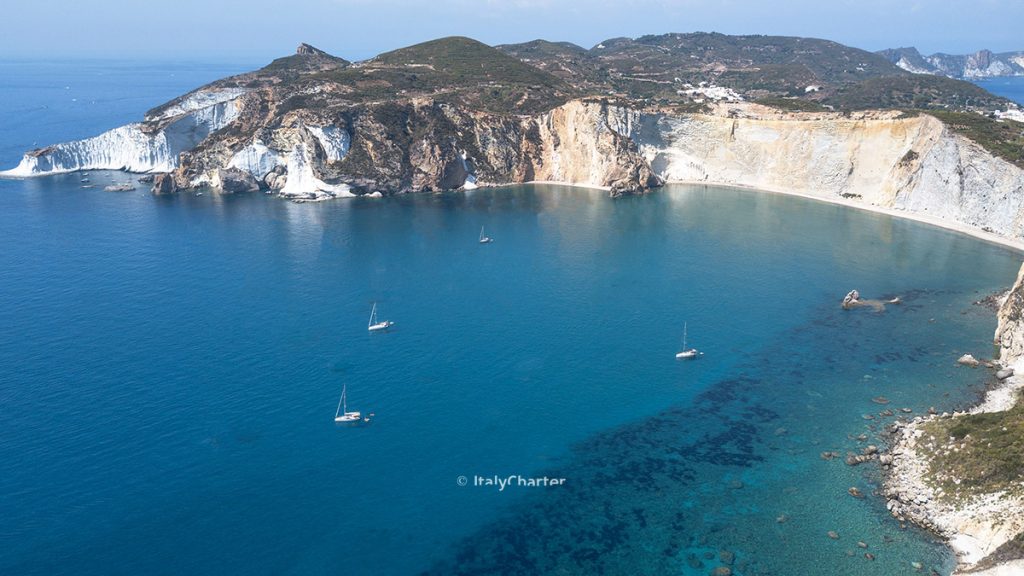
Ponza, the largest of the islands, is white and lush with laurel, euphorbia and broom. On the southeastern coast, well-sheltered from the Mistral, the island’s picturesque harbour is set in a natural amphitheatre created by the Madonna and Punta Bianca hills. It was designed by the Bourbon rulers on two levels: one for the quay, and a higher level for the pastel-hued houses. There are plenty of boutiques to browse around at leisure, before sitting down to sample some fried fish at one of the seafront eateries.
On the promontory to the south of the bay, you can venture into the stunning Grotte di Pilato; this Roman-era cave complex looks out onto the bright turquoise sea. Sailing along the northeastern side of Ponza, you come to Cala Frontone, then the monumental Arco Naturale (Natural Arch) that rises out of the azure water.
From Punta dell’Incenso, overlooking the islet of Gavi, you can sail towards nearby Zannone, an island that is part of the Circeo National Park. It was the site of a Cistercian monastery several centuries ago, but is now silent and uninhabited.
Or you could stay near Ponza and explore along its western side, which is interesting to sail around and has a striking landscape with coves, cliffs and rocky areas for snorkelling. Even with a brisk easterly wind, you can always find sheltered mooring places here, such as Cala dell’Acqua; in May it becomes a triumph of scented broom shrubs.
Cala Feola has natural pools in the rock, perfect for diving. Those in search of a spectacular sunset should drop anchor in the Lucia Rosa bay and row around the sea stacks in kayaks.
Further south is the famous beach at Chiaia di Luna. Rising above the narrow half-moon of sand, lapped by crystal-clear water, are white tufa cliffs, grooved and moulded into bizarre shapes by the east wind.
Six miles west of Ponza you can explore Palmarola, a semi-inhabited island that takes its name from the dwarf palm trees. It resembles the Thai islands with its exotic landscapes dotted with caves, beaches and animal-shaped rocks. A truly unique spot is Cala del Porto, with twin bays divided by a sea stack. Pirates used to hide out at Cala Brigantina, which is sheltered by a steep cliff on its north and east sides.
A strong tailwind will make for a pleasant crossing to reach Ventotene to the southeast. This dark, wild island resembles a ‘whale’ of yellow and brown tufa, rising out of the waves, lush with myrtle, mastic, agave and prickly pear shrubs.
The whale’s ‘head’ rises up to the right (where Punta Eolo is), and its ‘tail’ dips down to the left towards Punta dell’Arco. It is bathed by a sapphire blue sea, rich in archaeological relics and a paradise for sailors and scuba divers alike. Two eventful millennia of history have seen this island go from being a stopping place for the Phoenicians and Greeks, to the holiday home of Emperor Augustus.
It also fell under the rule of the Farnese and Bourbon dynasties, who deforested and built on the island in the 18th century, giving it its current appearance. From the Roman age to modern times, Ventotene and Santo Stefano have acted as prison or place or exile. The ruins of Villa Giulia at Punta Eolo bear witness to this past, with fragments of mosaics and wall paintings. When approaching the main town on Ventotene, facing forward you will see the sorbet-hued houses built into the rock, along with the Pozzillo hemicycle.
The town’s harbour, Porto Romano, is stunning and dug into the tufa. However, its berths are only available to small, locally-owned boats or shallow draught vessels. But not to worry: if you need all the amenities, you can moor at Cala Rossano.
Ventotene has a rugged coastline with a sheer drop into the sea. The most popular natural harbour for boats seeking a safe haven from the north and north-westerly winds is Cala Nava, sheltered by the Nave di Fuori cliff.
The Pontine Islands are ready for you.
Don’t leave them hanging there! Find your boat now.
Look on ItalyCharter for boat rentals in Ponza.
Neapolitan Islands and the Amalfi Coast: where myth meets nature
The Bay of Naples is one of the world’s most spectacular cityscapes, rivalled only by Rio de Janeiro or Cape Town. What’s more, its history goes back millennia and has left fascinating traces in the form of architecture and culture.
With the iconic silhouette of Mount Vesuvius to the east, it is framed to the south by the Sorrento Peninsula, and to the north by the Phlegraean Fields (Campi Flegrei), a landscape formed out of an ancient ‘super volcano’. The islands in the Neapolitan Archipelago rise out of the sea: Capri, Ischia, Procida, Vivara and Nisida (which is connected to Naples by a causeway).
Having rounded Punta Campanella, the Amalfi Coast opens up before you; a vertical landscape that drops into the sapphire and jade green Tyrrhenian sea. This is where the mountains meet the waves, amidst cubic, pastel-hued houses (which inspired the graphic artist Escher), and the ribbon of asphalt that dashes between the iconic villages like a dizzying arabesque: Positano, Amalfi (with its iconic medieval cathedral), Atrani, Ravello, Cetara, Minori and Vietri, the town known for its cheerfully-coloured ceramics.
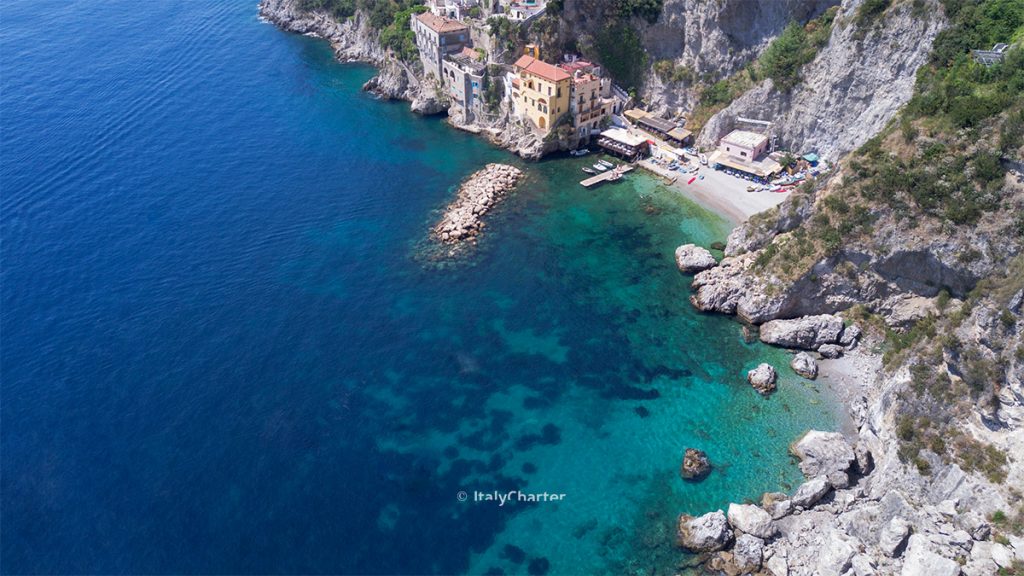
Then, there is the island of Capri: it has been a coveted tourist spot for more than two thousand years, and was the favoured holiday spot of Roman emperors and famous playwrights. The island is lush with cypress trees, citrus groves, vineyards and exotic gardens that you can explore along its panoramic paths. Its coast is dotted with sea caves, hidden beaches and little bays, many of which can only be reached by boat. Set into its steep cliffsides are luxury villas, resplendent with cascades of wisteria and bougainvillaea.
Yachts can drop anchor off Marina Piccola or at Marina Grande (Capri’s main harbour). Capri’s ‘piazzetta‘ is a small but lively place where people flock for aperitivo hour. Fancy a spot of designer shopping? The boutiques along Via Cappannelle are the place to go.
Don’t miss Grotta Azzurra, Villa Damecuta and Villa Jovis (the residence of the Emperor Tiberius); and of course the Certosa di San Giacomo, the Belvedere di Tragara overlooking the iconic Faraglioni rocks, and Villa San Michele in Anacapri.
Ischia is a very different place. Known as the ‘green island‘, it is dotted with picturesque fishing harbours: Sant’Angelo, Forio, Lacco Ameno, Casamicciola and Ischia town. This island is blessed with the largest number of hot springs in the whole of Europe. They were much-loved by the ancient Greeks and Romans for their incredible therapeutic properties.
We recommend setting aside a day to relax at the Giardini Termali Poseidon, a lush sub-tropical park and spa set in the stunning bay of Citara, where you can soak in pools of various temperatures, and experience natural saunas. Another beautiful spa is the Giardini Termali di Negombo, in the verdant bay of San Montano; you can safely drop anchor in this cove, which has fine sand and clear, shallow water.
All around the coast of Ischia you’ll find beaches with pine forests and hills criss-crossed with vineyards of local grape varieties such as biancolella, piedirosso and guarnaccia. The highest point on the island is Monte Epomeo, an extinct volcano. Climb up to its peak to admire views of the Bay of Naples and the island of Procida, the smallest in the archipelago.
Ischia’s Aragonese Castle is utterly spectacular. It stands on its own islet, connected to Ischia by a causeway; you can drop anchor on either side and feast your eyes on this fairytale setting. The picturesque marina at Forio has berths for boats and yachts up to 40 metres; Forio village has plenty of boutiques, restaurants and outdoor cafés. Another beauty spot is Lacco Ameno, famous for its ‘mushroom’ of tufa rock that rises out of the sea.
With its rococo, Moorish flavour, the beautiful and more unassuming island of Procida was once a flower that fell from Mount Epomeo on Ischia, or so legend would have it. With its strong maritime culture, matriarchy and deep-seated religious fervour, this island has cast its spell on movie directors, from Cinecittà to Hollywood. More than thirty films have been shot here since the 1950s, including The Talented Mr Ripley and Il Postino, not to mention countless commercials.
Built in the 17th century, the vibrantly-painted fishing village of Corricella has become the classic postcard-view of Procida. The island has three harbours. The main one, on the north side, is Marina Grande, and it is also a ferry and hovercraft port. Adjacent to it there’s a modern and fully-equipped tourist marina. The third harbour is to the south, in the bay of Chiaiolella, which is small but offers shelter from almost all the winds. Close by is Chiaiolella beach, a strip of volcanic black sand which is Procida’s largest and most popular public beach.
Holiday like a vintage movie star!
Pick your boat now and set sail in the deep blue sea of Campania.
Discover our yacht charter service
The seven sisters of the sea the Aeolian islands
As legend has it, the island of Lipari was home to Aeolus, the god who could predict weather conditions and the winds by observing the shape of the smoke rising from a nearby active volcano – essentially a meteorologist before the term was invented.
Nicknamed King of the Winds, Aeolus became immensely popular, and he lends his name to this stunning archipelago off the north-east coast of Sicily, which was declared a UNESCO World Heritage site in the year 2000.
International celebrities flock to the ‘seven sisters’ (Lipari, Salina, Vulcano, Panarea, Stromboli, Alicudi and Filicudi) and moor their superyachts in the crystal-clear waters around the volcanic islands, which are also a perfect destination for families and young people.
Each of them is special in its own way.
As legend has it, the island of Lipari was home to Aeolus, the god who could predict weather conditions and the winds by observing the shape of the smoke rising from a nearby active volcano – essentially a meteorologist before the term was invented.
Nicknamed King of the Winds, Aeolus became immensely popular, and he lends his name to this stunning archipelago off the north-east coast of Sicily, which was declared a UNESCO World Heritage site in the year 2000.
International celebrities flock to the ‘seven sisters’ (Lipari, Salina, Vulcano, Panarea, Stromboli, Alicudi and Filicudi) and moor their superyachts in the crystal-clear waters around the volcanic islands, which are also a perfect destination for families and young people.
Each of them is special in its own way. Lipari (the largest) with its stunning pumice beaches, monuments and hot springs; Salina, a foodie’s paradise; Vulcano and Stromboli with their untamed nature; the exciting nightlife of Panarea; and Alicudi and Filicudi, the most remote and peaceful of the seven.
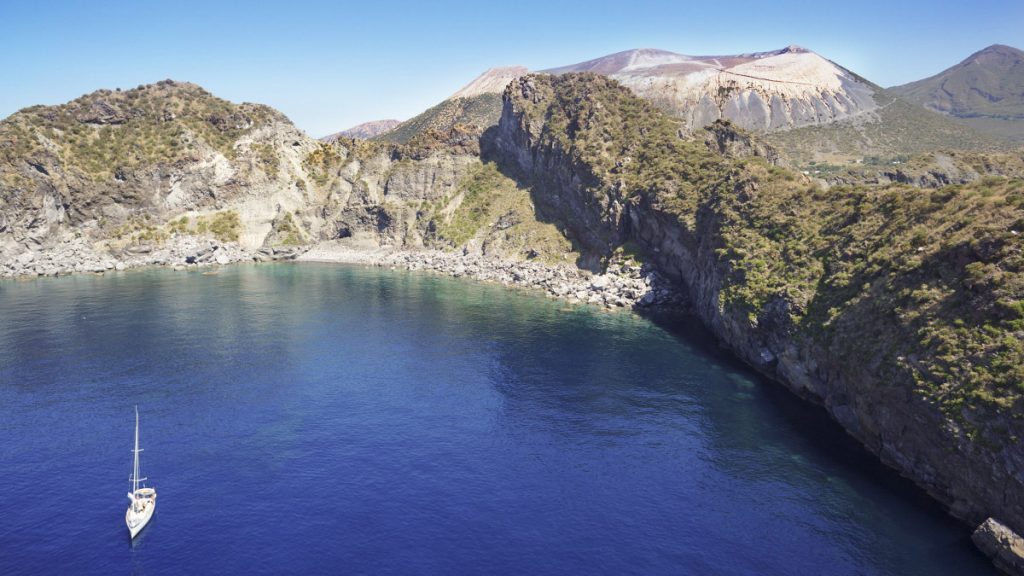
The lively main island of Lipari gives you a taste of authentically Sicilian colours, sounds and scents. The old town is dominated by the 16th-century Spanish castle and the city – with the cathedral of San Bartolomeo, the Aeolian Museum and the archaeological park – stretches down to the picturesque old harbour, Marina Corta, bustling with bars, eateries and ice cream shops where you can taste the velvety granitas – choose from coffee with cream, almond or lemon flavours. The two marinas where we can berth are Marina Lunga and Porto Pignataro, just north of the centre.
The southern coast of rugged Lipari is where the purple Aeolian lily grows, and the sea stacks rise out of the water (Pietralunga and Pietra Menalda); yellow-legged seagulls are regular visitors. Mooring here can be a challenge, but it’s worth spending at least half a day. Afterwards you might like to continue as far as the small Bay of Valle Muria, wedged between two tuffaceous headlands, with awe-inspiring views of the island of Vulcano.
Meanwhile, along the northern coast of Lipari you will find the Bay of Porticello, where you can drop anchor opposite a spectacular disused pumice quarry. Along this stretch of coast, you can also see the world-famous Spiaggia Bianca, where dazzling white sand turns the water a bright turquoise.
Steering northeast we reach the jet-set favourite Panarea, the smallest and oldest island in the archipelago. It is covered with prickly pear, mastic, agave, broom and caper plants, and ancient olive trees that bear witness to its agricultural past. This is the favourite destination for celebrities, who flock here to spend their holidays in sumptuous villas set among gardens of hibiscus and bougainvillaea.
The immaculate town of San Pietro stands on the central-western side of the island; there are two buoy fields where you can drop anchor and take a taxi boat to the shore. Step ashore on Panarea and have a cocktail at one of the trendy lounge bars with terraces or stroll along the picturesque waterfront. At night, then, you can dance until dawn in the coolest night clubs in Sicily.
A fun place to drop anchor is among the multitude of craggy rocks and islands scattered off San Pietro: their names are Le Guglie, Bottaro, Basiluzzo, Lisca Nera and Lisca Bianca. The latter is ideal for sipping an aperitif in a chic outdoor lounge, before diving into the sea warmed by the fumaroles of the underwater volcano.
If you prefer a more down-to-earth atmosphere, on the southwest side of Panarea you will encounter two arrestingly beautiful anchorages: Cala Zimmari, the ‘red beach’ and Cala Junco, an amphitheatre of rock that forms a fantastic natural pool, with water in a palette of emerald green, turquoise and deep sapphire.
Then, it’s time to unfurl the sails and head for around 10 miles towards Stromboli on the northeastern edge of the archipelago.
On the horizon a volcano appears, almost 1000 metres high, rising vertically out of the water. Due to its constant explosive activity, it spurts out a flurry of fumaroles, lapilli and magma. Watch it by night and witness the so-called Sciara del Fuoco, the river of incandescent magma flowing down the valley – an awe-inspiring sight.
Climbing up to the crater is an arduous three-hour hike with an elevation gain of around 900 metres. But the views from the summit and the excitement of a possible eruption makes it all worthwhile. Even if you decide not to tackle the climb, sailing around the coast of Stromboli is an experience not to be missed, to observe the magma moving from every angle.
There are no marinas on the island, only anchorages with fairly deep seabeds. The best is off Fico Grande, opposite the villages of San Vincenzo and San Bartolo. You can also drop anchor near Ginostra, on the southeast of the island, and stroll around the whitewashed village.
Tranquil Salina could be your next port of call. It lies in the middle of the archipelago and has freshwater springs that have allowed vegetation to flourish: you’ll spot citrus groves, gardens in bloom and vineyards of Malvasia, producing excellent local sweet wine.
On the cone of Monte Fossa there’s even a forest of ferns, which has earned Salina the nickname of “green Pearl of the Aeolian islands”. It’s also famous for being the location for several scenes of the film Il Postino, the final masterpiece of actor Massimo Troisi.
On the east coast, the pretty village of Santa Marina offers a well-equipped tourist harbour. Sailing around the island you will encounter other gems, including the bay of Lingua, once home to the salt pan that gave the island its name. Here there’s a fishing village and a saltwater lake enclosed by two strips of sand with a lighthouse at the far end.
Meanwhile, Rinella has a crescent of black sand with shallow water. Snorkellers can catch a glimpse of the sconcassi, underwater gas fumaroles gushing up from the seabed.
To the west, you can drop anchor near Pollara, an amphitheatre formed out of an extinct volcano, with cliffs and a natural arch. Traditional wooden fishing boats are kept on a staircase dug into the rock, sheltered from the winds and tides – take a look by sailing close to the coast.
The remotest islands are Alicudi and Filicudi. The former requires a long crossing and has limited mooring places, while the latter is a must-see. On this minuscule island, untouched by mass tourism, craggy red and brown rocks forge a dramatic, unique landscape. Its two villages (Filicudi Porto and Pecorini) have their own authentic atmosphere, far from the madding crowds. Pecorini a Mare is truly magical. A handful of salt-weathered houses stand on a beach of black sand, where colourful fishing boats rest. Children play barefoot in the square, while in the evening you can sip drinks while relaxing on huge cushions.
Before heading back to your charter base, make sure you fit in a visit to the southernmost island, Vulcano. You can moor on the buoys or jetties at Porto di Levante, before strolling around the busy little town with its multitude of bars and restaurants. Don’t miss bathing in the therapeutic mud of the sulphur springs near the beach: let your body succumb at last to total and utter pampering in a dramatic, Dantean setting.
One of the most enchanting spots to while away a day at sea is the remote Baia del Gelso, to the south of Vulcano (sheltered by the Mistral); alternatively, we recommend the Grotta del Cavallo or Piscina di Venere (on the west of the island) for an idyllic place to swim in calm, emerald waters, sheltered by the easterly and northerly winds.
Want to travel among the seven sisters of the King of the Winds?
Start planning your next cruise in the Aeolian islands now.
Find the right charter yacht for you.
Aegadian Archipelago: fishing tradition and an endless summer
The westerly Mistral blows constantly over the Egadi (or Aegadian) Islands, much to the delight of expert yachtsmen.
They include three delightful islands, Favignana, Levanto and Marettimo, along with the islets of Formica and Maraone.
The archipelago lies a few miles off Trapani on the western coast of Sicily. The biodiversity of the incredible turquoise sea here is protected as it is part of the Mediterranean’s most extensive marine reserve, set up in 1991.
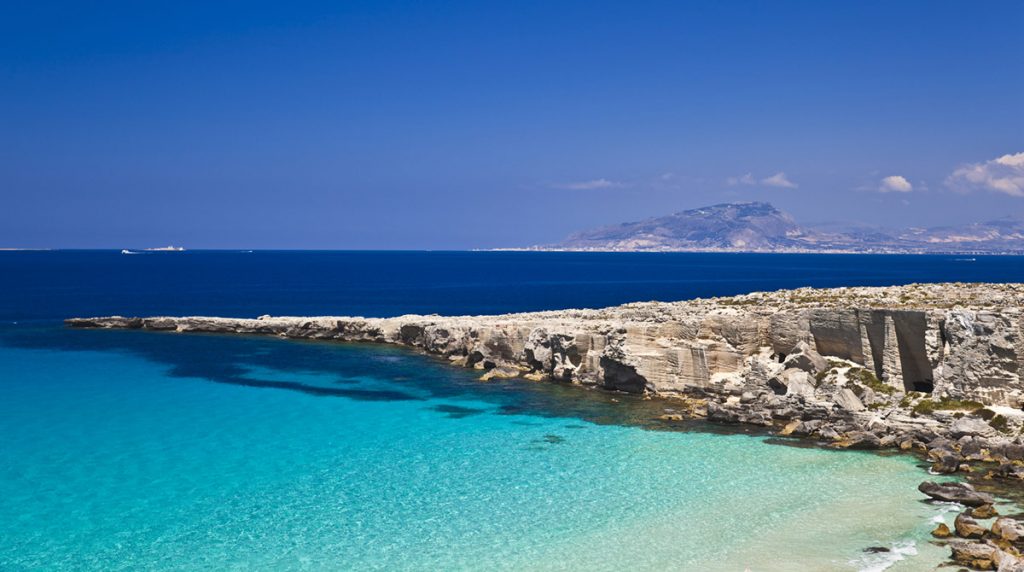
This area is home to the Mediterranean’s largest Posidonia Oceanica seagrass meadow, and vast expanses of coral. The archipelago is the favoured habitat of the Mediterranean monk seal, the Loggerhead sea turtle and several rare shark species.
Some of the fish species you might encounter in its clear waters are the dusky grouper, which swims on the seabed; the amberjack, shi drum, corvina, dentex and zebra seabream. The residents of these rocky, cave-dotted isles live in blue-shuttered white houses along winding lanes and little squares. The effect is a scenic living postcard that will charm those travellers seeking unspoilt beaches, authentic traditions, peace and relaxation.
The largest is Favignana, which is also the capital of the archipelago. It takes its current name from the local name for the westerly wind, the Favonio. It is shaped like a butterfly hewn from sandy tuff, with flat wings and the towering Santa Caterina massif at its centre.
While the terrain is arid in the summer, in springtime – one of the best seasons to visit, given its mild climate – the blossoming garrigue (mastic, carob, spurge, sumac) and rock plants transform the island into a fragrant, colourful delight.
For centuries, the only form of livelihood on Favignana was fishing. Its famous Florio Tonnara (the disused tuna fishing complex) is now a large maritime museum. Favignana town has a harbour where vessels can moor safely, sheltered from the wind.
One of the island’s most striking features is its sunken gardens, located in disused limestone quarries that are now lush orchards planted with orange, lemon, carob and almond trees.
One of the prettiest landing places is Cala Rossa, a spotless beach with almost impossibly turquoise waters, framed by rocks.
Cruise around the island to enjoy striking views of the chain of inlets and islets, particularly along the south coast, with sandy and shingle coves in the area around Punta Longa, Preveto, Faraglioni, Calamoni and Puntazza.
You can berth at the small marina at Punta Longa, which offers shelter from the northerly winds. For spectacular sunsets, head to Punta Sottile at the westernmost tip of Favignana. And don’t miss the sea caves – such as the Grotta dei Sospiri – which can only be reached by boat.
Visit the archaeological site of San Nicola to admire a Roman nymphaeum, the Bagno delle Donne, a ladies-only bathing area. There are also the ruins of a fish and garum (piquant fish sauce) production plant.
It’s just three miles across the water from Favignana port to Levanzo, with its steep, jagged coastline. The village of the same name is a picturesque cluster of low whitewashed houses curving around the harbour, overlooking crystal-clear waters. There are no roads on the island, bar the one which leads to the island’s Faraglione.
With its twelve kilometres of coastline and just two hundred residents, tranquil Levanzo is a good option if you’re looking to get away from it all. Island life revolves around Cala Dogana, the only village. You can discover the farthest-flung coves by boat, such as those on the south-eastern coast: Cala Fredda, and the wilder Cala Minnola, set among a beautiful pine forest.
Don’t miss the Grotta del Genovese, a cave dating from the Palaeolithic-Neolithic era, complete with graffiti and cave paintings.
Adventurous scuba divers are in for a treat: Levanzo offers an incredible underwater archaeological itinerary: the remains of a Roman shipwreck, wine amphorae and fragments of vases from the 1st century B.C. lie on the seabed between Cala Minnola and Punta Altarella.
Marettimo is the westernmost island in the Egadi. This tiny fishing community will charm visitors looking for a slow pace and a down-to-earth mood far from the crowds. The fishing nets spread out to dry in the sun, wooden dinghies, old ladies chatting in the square… these snapshots of life as it used to be are practically impossible to find elsewhere.
In geological terms Marettimo is strikingly different from her “sisters” – the islands broke away from Sicily thousands of years apart. This island is of karstic origin, and its towering mountains of white rock soaring out of a cobalt sea, and its many grottoes, are truly spectacular.
Back on the mainland, just seven miles from Favignana, is Trapani, and a stretch of pristine coastline. Sailing northwards, we reach Bonagia, then the bay of Macari and the Baia del Bue Marino.
At the north-western tip of Sicily (or “Trinacria”, to use its ancient name), is San Vito lo Capo, which offers a well-equipped marina. San Vito is famous for its Caribbean-style beach, a long strand of golden sand, with the gleaming white village at one end and the Monte Monaco promontory at the other. Don’t leave before tasting the local specialty, fish couscous, in one of the many restaurants along the seafront.
Heading southeast, you come to the Zingaro Nature Reserve, an idyllic stretch of coast in which limestone cliffs drop sheer into the azure sea, with tiny white sandy beaches here and there. The village of Scopello is a cluster of picturesque buildings, the most remarkable being the 13th-century tonnara, overlooked by two 16th-century watchtowers. Dramatic sea stacks soar out of the cobalt sea: diving off them is a not-to-be-missed experience.
In the shadow of Monte Inici, Castellammare del Golfo is one of Italy’s most delightful fishing villages. Its origins date back to the 5th century BC, when it was built as a port serving nearby Segesta. As you approach from the sea, you can immediately make out the majestic 10th-century Arab-Norman castle, standing high on a small headland. In the town itself, you can admire the baroque Sanctuary of Maria Santissima del Soccorso, the 17th-century Palazzo Crociferi, and the Piccolo Museo del Mare; after dusk, step into the buzzing nightlife around the harbour.
Having sailed around Punta Raisi and Capo Gallo, you reach the dazzlingly white sand of Mondello, Palermo’s famous beach, lapped by impossibly turquoise waters. Sicily’s lively capital city is alive with artistic and architectural heritage, where Moorish cupolas crop up among Art Nouveau palazzi and baroque churches. It’s also a foodie’s paradise!
Palermo is just fifty miles from Trapani and makes the ideal endpoint of a cruise offering plenty of variety and interest for keen sailors and culture buffs. In the city centre is Palazzo dei Normanni, Europe’s oldest royal palace (9th century), and the Ballarò market, a melting pot of smells, flavours and culinary traditions. What better place to dive into Sicilian folk culture? Down by the port, the Vucciria quarter has always been the city’s main fish market and is now the ultimate place to go for Palermo-style street food. Wander around the many kiosks and sample the town’s classic delicacies: from potato croquettes to fried fish, panini stuffed with spleen, swordfish roulades, boiled octopus and battered vegetables. All washed down with an ice-cold beer, of course!
Fishing villages and gourmet feasts in splendid Sicily.
Boat trips from Trapani to Palermo with ItalyCharter.
Open our catalogue of boat charters in Sicily.
Tremiti Islands and Gargano: immaculate beaches, rocky coves, caves and an open-air museum
Few places in the world present such a concentration of beauty as the Gargano and the Tremiti Islands. Together, they form an incredible destination for a sailing cruise of a week, or longer. Situated around twelve nautical miles off the coast of Puglia, the Tremiti Islands are the only Italian archipelago in the Adriatic sea, with the exception of the Venice Lagoon.
Rocky and off the beaten track, these isles are surrounded by crystal-clear azure waters. They are part of a protected marine reserve and have a history that will fascinate even the most demanding traveller. As legend has it, the Homeric hero Diomedes stopped off on these shores before going on to spread Greek culture through much of the Mediterranean. Indeed, the sea birds commonly found around the Tremiti are called ‘Diomedee’.
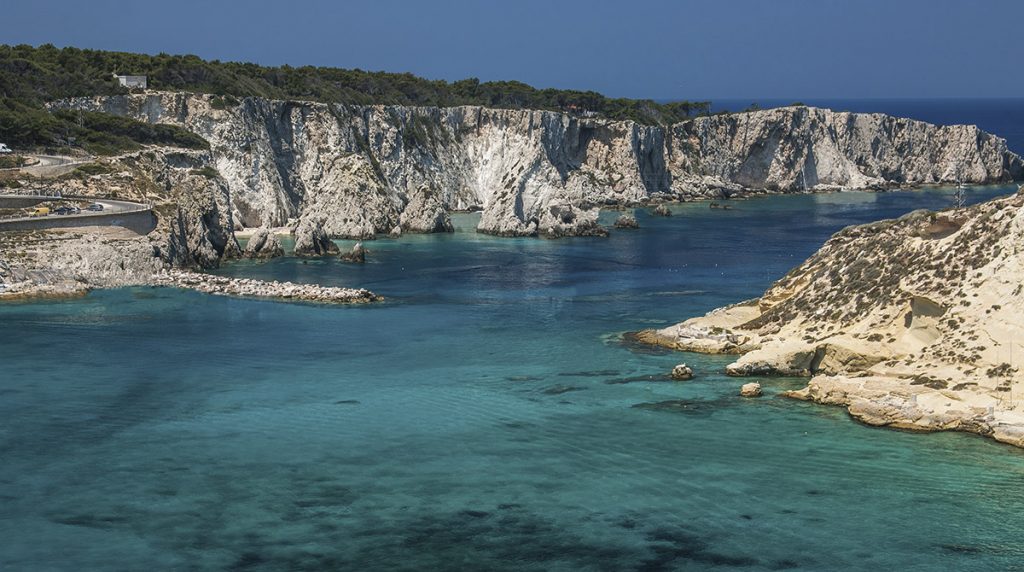
The main hubs of the archipelago are San Domino (the largest island), and San Nicola. These are the only two inhabited islands, and they stand just two hundred metres from each other, separately only by the clayey islet of Cretaccio. Less than a mile away is Capraia; the name derives from a contraction of capperaia, a reference to the abundance of native caper bushes.
The greenest of these islands is San Domino. It wears a mantle of Aleppo pines and the Benedictine monks dubbed it the ‘Orchard of Paradise’. As we circumnavigate the island, we come across numerous grottoes: the Bue Marino, the Viole, the Rondinelle… all can be spotted from onboard a boat.
San Domino may be small, but its old town is crammed with little bars, restaurants and boutiques, and a very pretty tourist harbour. Its northern coast is beautiful, with some must-see spots including Cala degli Schiavoni and the Faraglioni dei Pagliai, with tiny beaches that can only be reached by sea.
Rounding the cape to the north, we come to another stretch of rugged coast, with Cala degli Inglesi. On the way back to harbour, it’s worth stopping off at Cala Matana with its sheer cliffs; the bay became famous when the late singer-songwriter Lucio Dalla bought a house here. He even wrote a song about it: ‘Luna Matana’ was inspired by the enchanting full moons on the bay.
The two largest islands are so close they’re practically touching, making the crossing to San Nicola a piece of cake! Here, the monastery of Santa Maria al Mare, built by the Montecassino Benedictine monks, stand atop the imposing coastal massif. The place is an open-air museum; as you visit, lose yourself between its towers, fortifications, ramparts, churches and cloisters. There are also plenty of bars and restaurants where you can wind down after your cultural exertions.
Our route around the island ends at Punta Santa Maria, from where you can head towards the flatter island of Capraia, which has no trees or houses, but is covered with flowers and has been taken over by a vast seagull colony.
Mother Nature has been lavishly generous with the Gargano area of Puglia. With its distinctive terraced skyline, it slopes down from the ‘Tavoliere’ tableland towards the Adriatic coast. Sailing along its scalloped coastline is the best way to discover what’s known as the ‘Spur of Italy’. it has some two hundred kilometres of coast with looming limestone cliffs, coves of pristine pebbles and sand dunes, spectacular caves and ancient watchtowers.
The coast is dotted with picturesque fishing villages with whitewashed houses, such as Vieste, Peschici and Rodi Garganico. All of them are great places to stop over for some cultural and culinary delights and – why not – a spot of shopping.
Do you dream of a cruise around one of the loveliest spots on the Adriatic?
Caves, coves and Puglian beaches await…
Set off on a chartered yacht with ItalyCharter
Salento: Lecce’s Baroque architecture, beaches to rival the Maldives, olive groves and castles in the Heel of Italy
The Greeks christened Gallipoli Kalè Polis, meaning “Beautiful City”.
According to legend, the city was founded by Idomeneus from ancient Crete. Gallipoli stands on an island in the Ionian Sea, linked to the mainland by a bridge built in the 1600s, and is almost entirely encircled by its defensive walls, most of which were built in the 14th century.
The old town is bursting with noble palazzos and baroque churches, a gem of a place that has retained its old-world place of life: fishermen repair their nets on the wharf, go out fishing on traditional wooden gozzo boats and haul their catch back to shore. You can taste it for yourself in the fish restaurants along the seafront.
We’ll set off from ‘Kalè Polis’ for a cruise along the coasts of Salento, sailing from the Ionian to the Adriatic sea and rounding the southernmost tip of the “Heel of Italy”: Santa Maria di Leuca. Now a trendy destination for savvy globetrotters, the Salento is a chunk of calcareous rock situated at the furthest tip of Puglia. It is the realm of olive groves, fairy-tale bays, aristocratic mansions and cities with castles and amphitheatres, drenched in history left behind by centuries of rule by the Greeks, Byzantines, Romans, Normans and Spanish.
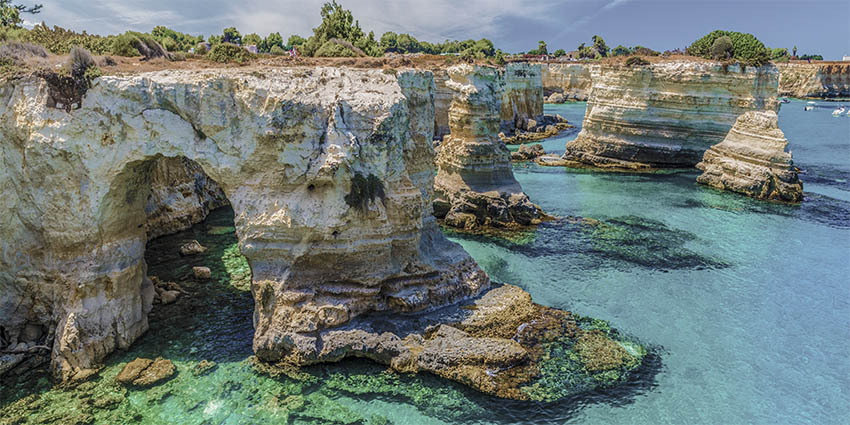
A cruise around here will give you the chance to dive into a sea that rivals the Maldives, and lounge on pristine sandy beaches. You can admire some fine examples of Lecce Baroque architecture, and marvel at the towers built to fend off the Saracen invaders. The cruise will take you around Torre Mozza, Santa Maria di Leuca, Tricase Porto, Castro Marina, Porto Badisco, Otranto, Torre dell’Orso, San Cataldo.
If there’s time, you might like to go on some excursions inland to explore the architectural gems that are Lecce, Copertino, Galatina and Nardò.
Before heading further south you might like to make a quick detour to the northwest. So, sail beyond the four tourist harbours in the new town, past the pastel-hued houses in Santa Maria al Bagno, and finally approach Porto Cesareo, which is in a marine reserve and has a modern port with plenty of facilities.
A beautiful spot near here is the Strea peninsula, a narrow strip of land covered in Mediterranean scrub; it spreads out to form a picturesque lagoon, with the Isola dei Conigli opposite.
Or you could continue from Gallipoli towards Santa Maria di Leuca instead, and sail beyond Torre Suda to reach the excellent anchorage at Torre San Giovanni, the cute little harbour at Torre Mozza, and the spectacular beaches at Ugento and Pescoluse, which are nicknamed the “Maldives of the Salento” and with good reason!
Santa Maria di Leuca is de finibus terrae, a land’s end battered by winds from all directions. Here, the Ionian meets the Adriatic, often generating tall, Californian-style waves on which local surfers show off their moves.
Sailing back up along the Adriatic coast, the immense, rugged cliffs are punctuated with grottoes and overlooked by watchtowers, set against a patchwork of terraced farmland and drystone walls. The reliably translucent sea has been awarded blue flag status several times over. On a clear day, as you cross the Strait of Otranto you can spot the Albanian mountains and Greek islands on the horizon. Stop off and dive into the emerald water at Tricase Porto, an exquisite little harbour with lovely bars and restaurants.
Further to the north is Castro Marina, overlooked by the town of Castro Superiore. The town was founded by the Ancient Cretans and Greeks. Its 16th-century castle towers above the rocky coast – there are no beaches here, but tourists flock to visit the famous Grotta di Zinzulusa. A few miles further on we come to Santa Cesarea Terme, a ‘vertical’ town built on three levels. This is a spa town, known for its water rich in salt, iodine and sulphur, and it boasts striking Art Nouveau and Orientalist architecture, as well as a beautiful harbour built into the limestone cliff.
Beyond the rocky cove of Porto Badisco, Otranto spreads out before you, lapped by intense azure waters and surrounded by idyllic beaches. It also has a well-equipped marina where you can berth. Otranto is a bridge between east and west and is known as the “city of Martyrs” due to the various episodes of bloodshed as invaders attempted to occupy the ancient trading hub.
Further north, beyond the pine forests of Laghi Alimini, we come to the marinas of Melendugno. The first is Sant’Andrea, with its limestone sea stacks soaring out of the jade-green water, and its shady pine groves; then Torre dell’Orso with the Grotta di San Cristoforo, and the rocks known as the “Due Sorelle” (Two Sisters). Lastly, San Foca, with a very well-equipped tourist port that is one of the main marinas between Brindisi and Otranto. This stretch of coast has plenty of sandy coves and large rocks rising out of the waves, including the famous Scoglio dell’Otto. For a memorable meal, stop off to sample sea urchins and seafood at one of the wooden huts built at the water’s edge.
Those opting to charter a boat in Taranto can explore the beautiful attractions of the “city of two seas”, which lies between the Mar Grande and the inland sea, Mar Piccolo. You might even spot some members of the dolphin colony that lives in the Mar Grande, around the Cheradi Isles.
Taranto was the only Spartan colony in Magna Graecia. It boasts several millennia of history and has a solid seafaring tradition, as can be seen from its vast Arsenale Marittimo belonging to the Italian navy. From Taranto, you can sail south-eastwards towards the marine reserve of Porto Cesareo or follow the sweeping arc of the Gulf of Taranto, sailing along the low, sandy coast to reach Marina di Policoro, a seaside resort built along three kilometres of unspoilt beaches.
The tourist harbour at Marina di Policoro has moorings for vessels of up to 40 metres, as well as a yacht club, shipyard, café, restaurants and boutiques. The spectacular city of Matera, a UNESCO World Heritage site, is less than one hour away by car.
The Ionian Sea is bustling with sea life. Dolphins and sea turtles swim undisturbed in the bay. The Spiaggia del Bosco Pantano di Policoro is a beach that has been declared a “site of importance for the community” for its natural, scientific and scenic value. The sea here is so clean that even the Caretta caretta turtles come here to breed.
Policoro is ideal for families, and has a renowned sailing school where even younger children are taught sailing and watersports.
Uncontaminated seas, emerald waters and a region rich in history.
Discover a breathtaking array of beauty in the Salento.
Start planning your cruise on board an ItalyCharter yacht.
Northern Adriatic: from the magic of Venice to the unspoilt Croatian coast
Arriving in Venice on board a sailing yacht is a spellbinding experience.
Picture the scene: you set off from charming Chioggia, a small city at the southern edge of the Venetian Lagoon, with lanes, canals, bridges and houses in pretty pastel colours, and head north. As you glide across the sea at sunset, the bow slices through the water, rippling in the light of the golden hour.
Having crossed the stretch of sea between the northernmost tip of the Isola del Lido and Punta Sabbioni, La Serenissima appears before you in all her glory.
Moor at the marina on the island of San Giorgio, which offers amazing views of San Marco, and as the dusk turns the world blue, uncork a bottle of prosecco to celebrate. You have arrived in Venice, a city like none other, not to mention a world heritage site!
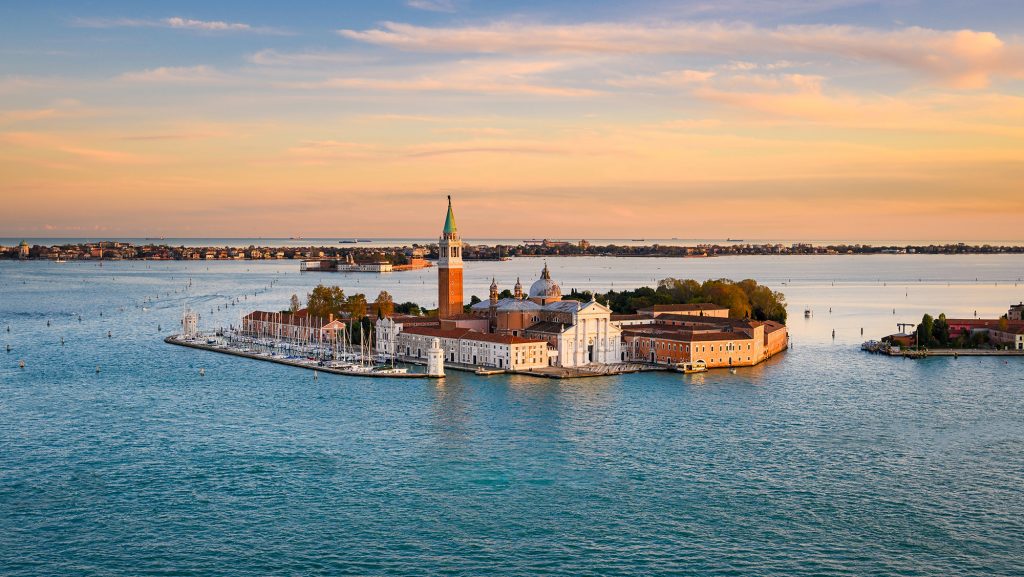
This and many more privileges await those who choose to visit Venice by boat. Such as enjoying the islands when the crowds have gone, after the vaporettos have taken the tourists away. From rural Pellestrina to the glamorous Lido; from Burano with its colourful fishermen’s cottages, to Murano, the world capital of blown glass; from San Lazzaro degli Armeni – a tiny islet completely taken up by its monastery – to Torcello, home to the Basilica di Santa Maria, the remains of the Baptistry, and the church of Santa Fosca.
The northern Adriatic has plenty of exciting other destinations to offer too. You’ll explore them as you steer between the sea and the lagoons, along canals and endless beaches, exploring Romanesque churches and remote villages. Heading north, you’ll come across the vast sandy beaches of Jesolo, Bibione, Lignano Sabbiadoro, and the Laguna di Marano with its crowning glory: the town of Grado.
Grado, also known as the Isola del Sole, continues its tradition as an ancient fishing village. Its old town is a maze of alleys and little squares, and its Y-shaped harbour is where everyone gets together.
All around are sandy beaches, and the lagoon, where various kinds of batela can be seen; these are traditional flat-bottomed boats, originally fitted with sails or oars, now with motors too. The little islands here still have their casoni, traditional fishermen’s dwellings with thatched roofs.
Continuing eastwards you’ll spot Trieste, a fine Mittel European city and a bridge to the east; it appears before you, proud and beautiful with its aristocratic Habsburg palazzos, and the masts of the yachts bobbing in the city’s seafront ports, known as the “Rive”. The busy waterfront stretches all the way from the piers at Porto Nuovo and Porto della Lanterna as far as the vast square, Piazza dell’Unità. You might be surprised to see so many local people sunbathing on the “Topolini”, (sun terraces), or at one of the elegant city beach clubs. Trieste has a visceral love of the sea, and a solid seafaring tradition stretching back centuries, as evidenced by its many ports, its valiant, record-breaking Italian sailors, and the incredible Barcolana, the world’s largest competitive regatta; open to any kind of vessel, it takes place every year on the second Sunday in October.
Sail around the scenic Gulf of Trieste and admire to the castles of Duino and Miramare; go diving to immerse yourself in the marine biodiversity in the Mirameo reserve beneath the Duino Cliffs, and have a swim in one of the many secluded bays along the rocky Triestine coast; they can only be reached on foot or by boat, and include the unspoilt Porticciolo di Santa Croce, and the beach at i Filtri.
If you’d like to extend your cruise beyond Trieste, Croatia offers a wealth of possibilities; from the coast of Istria, with its beautiful beaches and exquisite towns like Rovinj, to the striking islands in the Kvarnar Gulf, such as Cres and Losinj, with their gorgeous beaches and colourful Venetian-era villages.
Planning an unforgettable vacation?
Then Venice and Trieste are the ideal choice.
Contact us to charter a boat for the North Adriatic
How to request a quote for your yachting holiday
Have you already decided on your next destination for the boat cruise of your dreams? Making your dream come true isn’t that complicated if you pick the right charter agency. ItalyCharter gives you access to an impressive catalogue of charter vessels – both sailboats and motorboats – on which you can cruise your favourite Italian itineraries.
Fill in the contact form below to receive your tailormade quote.
We look forward to hearing from you!

